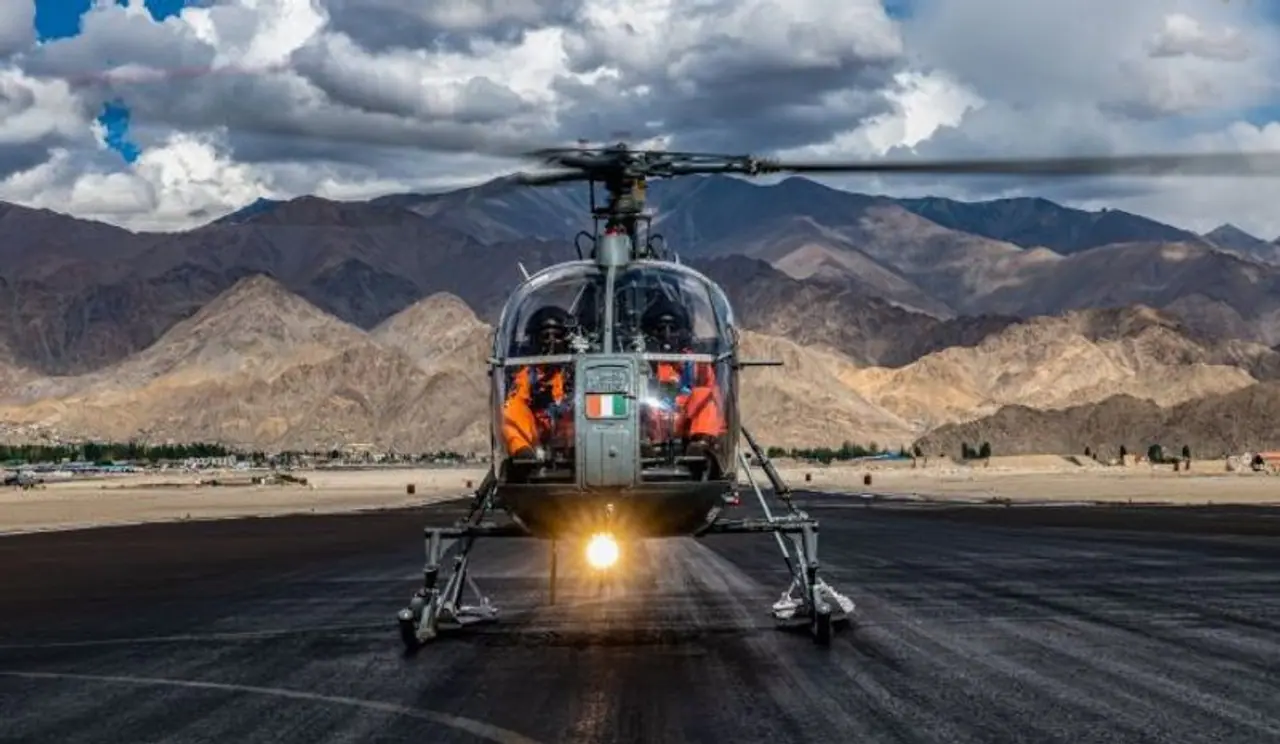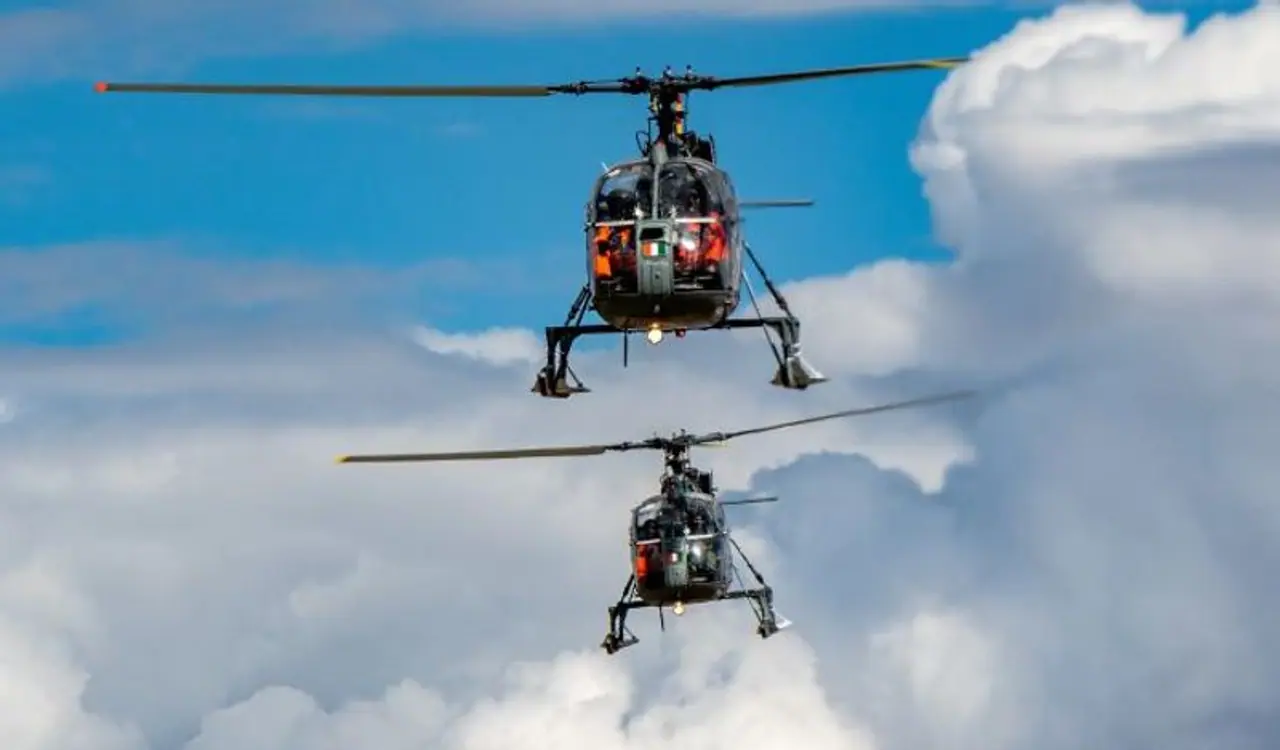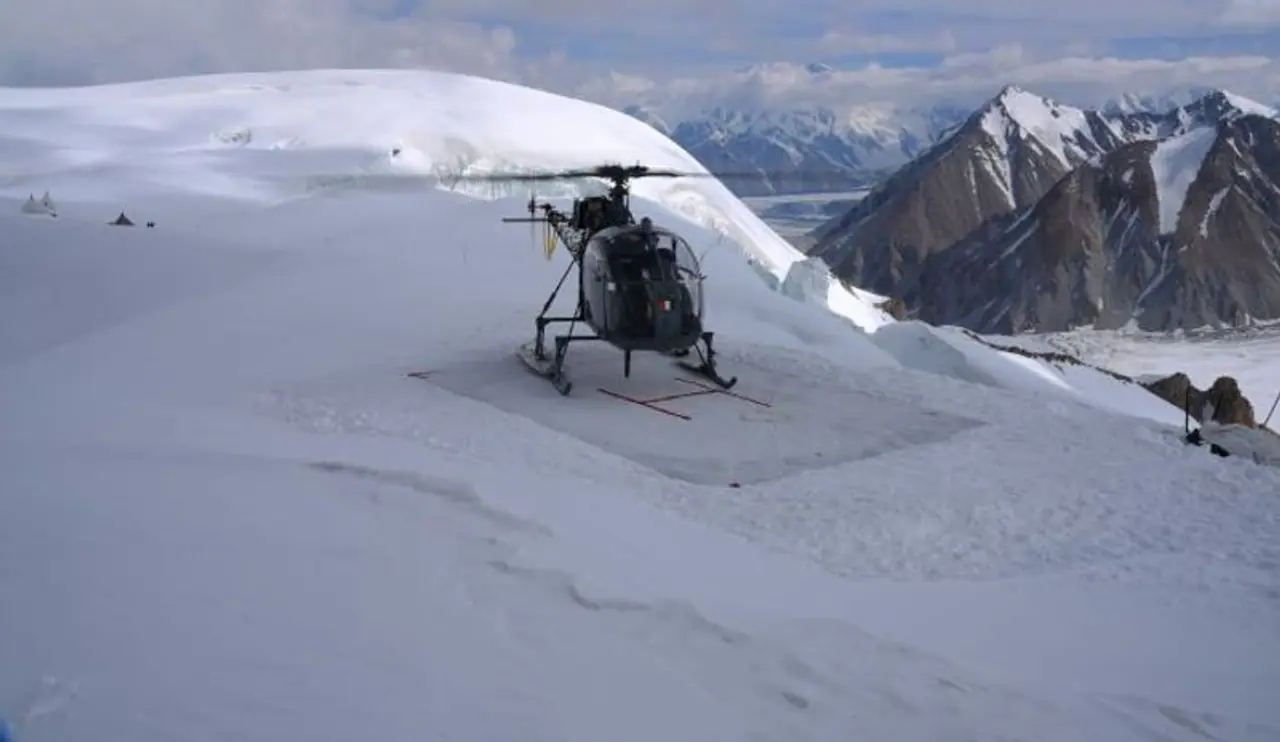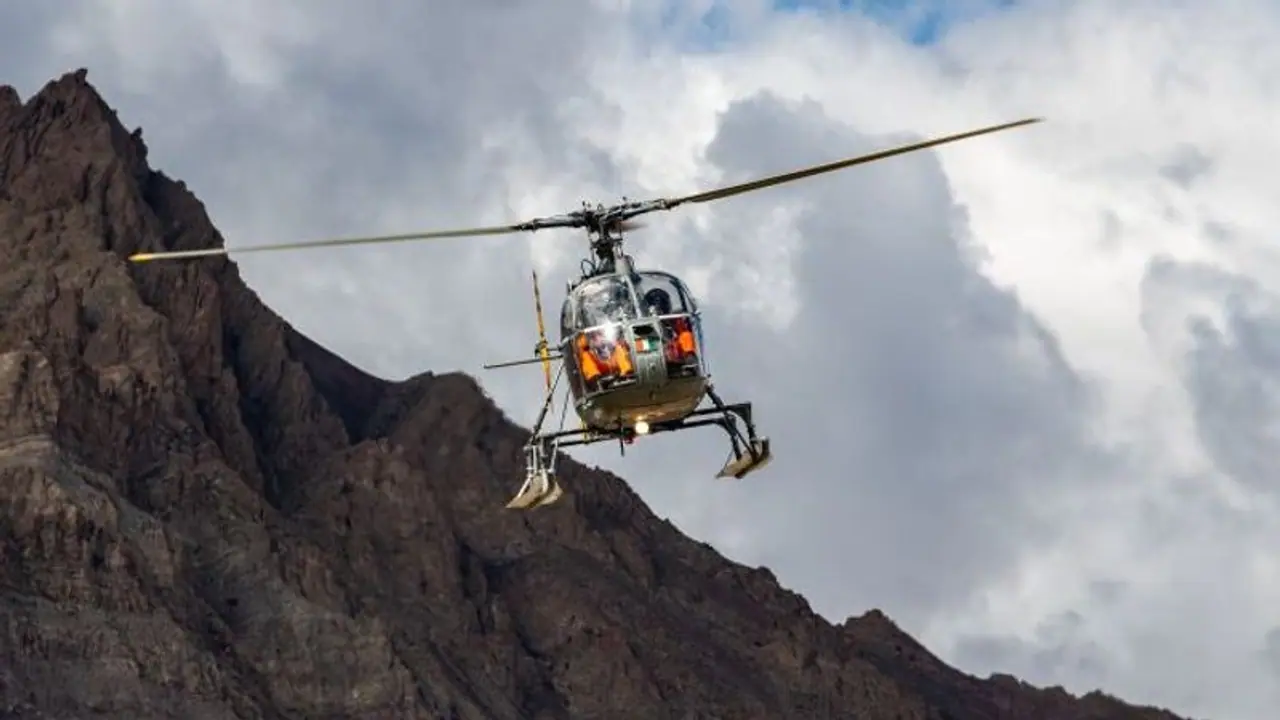Indian Air Force historian Anchit Gupta narrates the story of the 114 Helicopter Unit -- the 'Siachen Pioneers', a unit that has been continuously in operations the longest amongst all services, regularly faced nature, enemy fire and lost its own during peace. It remains a unique unit in the world of aviation.
Approved as the first all-Chetak unit on December 18, 1962, with eight helicopters, the 114 Helicopter Unit was raised on April 1, 1964, with two aircraft and was based at Leh -- replacing 107 Helicopter Unit's Mi-4 detachment stationed since the 1962 war. The 114 was the first permanent IAF unit at Leh, where it continues to this day.

Also Read: From the IAF Vault: How C-87 Liberator took India over Everest and beyond
Squadron Leader Arvind Dalaya moved in to take command. Other than pilots converting from Mi-4s, the unit also had five pilots from 83 PC who had directly been commissioned in helicopters after training in France. The unit made Leh-Srinagar-Jammu its permanent home for the next two decades.
Its initial steed, the French Alouette III, was chosen for it was nimble, lighter, reliable and had more reserve of power, even if lower carrying capacity. It is a tribute to the design that the aircraft continues to serve across the globe in its upgraded avatars.

Ironically, its service ceiling of 10,500 feet is nearly the elevation of Leh. It should thus never even have taken off from Leh, but then that is the story of the 114 -- grit, derring-do and gallantry on a daily basis! The journey was, however, not easy and costs had to be paid.
Early on, the unit got a taste of the hardship and courage the area demanded. An aircraft crashed while crossing Khardungla when its engine failed, while another had to be force landed at Murgo (16000 ft). Engine changes in remote locations were common.
During the 1965 war, the 114 engaged in casualty evacuation and mercy missions, flying with some Chetaks with a Red Cross livery. VIP sorties and intelligence-gathering missions were also flown. One aircraft was also damaged by shrapnel during a raid.
Between the 1965 and 1971 wars, the Unit establishment grew to 10 helicopters, including a detachment at Baramulla that gave aerial access to the Haji Pir area. Ladakh, however, remained the 114's primary area of operation. In August 1968, a helicopter from the 114 cleared the Chandigarh-Kulu-Keylong-Leh route -- a first for the IAF!
The 1971 war saw the unit again perform casualty evacuation and mercy missions amidst enemy fire, mostly in Kargil and Uri sectors. On December 5, a helicopter flown by Flight Lieutenant BS Chandel and Flying Officer SS Ramarao was shot down by an F-86 near the Srinagar airfield. Both miraculously survived.

On December 11, Second Lieutenant KL Bajaj and Flying Officer RR Patel flying Kargil-Dras, ducked into a valley to avoid shelling and hit high tension cables. Bajaj lost his life in the accident. The unit also earned two Vir Chakras -- Bartan Ramesh for his 45 missions and Sukhdev Dhillon for 87 casualty evacuations, with disregard to personal safety.
After the War, the unit was given an additional role and equipped with the AS-11B Anti-Tank guided Missile on some of its Chetaks. This role continued till about 1987, by when 114 Helicopter Unit had already made their tryst with destiny. This involved a certain area called 'the place of wild roses'.
Prior to his epic expedition to the Siachen, Col 'Bull' Kumar flew an aerial recce over the area on August 3, 1978, with Second Lieutenant Sambyal and Flying Officer AS Mann pioneering the IAF's forays over the world's '3rd Pole'. The 'Glacier Pioneers' had 'boldly gone where no pilot had gone before'.
In 1985, 114 Helicopter Unit was called the 'Glacier Pioneers'. Around 1990, this name was changed to 'Siachen Pioneers, ' which sticks to date, as they remain the avant-garde of helicopter flying. But first, let's return to the pioneering days
The first supply mission to Siachen followed in September 1978. Second Lieutenant Monga and Flying Officer Manmohan Bahadur then landed on the glacier on October 6, 1978, in Z-1410. This landing at 15,500 feet was a feat that has not been acknowledged as it should have. Siachen had been saved; six years before Operation Meghdoot was announced.
In between, the unit, continuing its 'civil aid' role, had earned unprecedented laurels, including a record five Shaurya Chakras for daring rescue missions -- four of these were for mountain rescues.
The government-authorised Operation Meghdoot to secure Siachen was formally flagged off on March 31, 1984. However, April 13 is often ascribed to be the start -- being the date when Indian Army troops reached Bilafond La, which is at the foot of Amar and Sonam -- the record-breakingly high helipads in the area.

The 114 started recce of the Siachen by end-March 1984, inducting troops to the 5-6 camps established by the Indian Army. Drops were executed short of Sia La/Bilafond La and casualty evacuation was undertaken on beaten snow. On April 13, Indian Army troops were dropped at Bila, where much blood from both sides was to be spilt.
Siachen is 70 km long and has subsidiary glaciers to the West, which terminate into passes (La’s) that overlook lower Pakistan Army positions -- Sia La and Bilafond La being the second main one. Whilst it may be able to observe certain areas, it is a canard that the Pakistan Army was ever on Siachen.
In 1981, Chief of Air Staff Idris Hasan Latif noticed the Air Officer-in-Charge Personnel flying the lighter Cheetah in Darbuk. He ordered an immediate change of type for the 114, too, resulting in the unit getting its first two Cheetahs. For the next six years, they flew both types -- becoming a Cheetah-only unit in 1987, thus also losing their ATGM role.
This was a welcome change since Siachen poses unique challenges. The crevassed terrain offers few landing spots. Wind speeds, turbulence, temperatures and clouding, can be extreme. But of all the natural elements, it is the altitude and lack of oxygen which affects men and machines the most. In Siachen, it is the Density Altitude, not the Pressure Altitude, that dictates aircraft behaviour. In layman's terms, it is the 'altitude where, performance-wise, the aircraft thinks it is at'. The usually higher Density Altitude is debilitating for aircraft performance.
Flying at the limits of aircraft performance necessitates careful calculation of the 'All-up Weight' of the aircraft. For a Cheetah flying here with a few extra kilograms of the ration can have lethal effects. A 'jugaad' calculator was thus created by the Pioneers and taped up to the instrument panel.
Siachen had Camps I, II, III (later named Kumar), IV & V. Bilafond La, Bhim, SiaLa, G3, Zulu, and Hoshiar were on 'branches'. Soman, Amar, Khanda, and Ravi helipads started in 1985 and were all at 15000-19,500 feet elevation! These were and still are forbidding heights by any measure.
The matchbox-sized helipads appearing to be on pillars add to the pilots' conundrum. Some weather conditions create a 'White Out' akin to being inside a pingpong ball, whereby all depth perception is lost. When there are no clouds, the glare from the snow hurts the eyes.
Also Read: Unmarried women can terminate pregnancy up to 24 weeks: Supreme Court
A coveted qualification (patch introduced in the 2000s), it takes some doing to be a Captain on the Glacier (Champ of champs). A 7-8 month effort, co-pilot flying hours to the highest helipads, conversion and clearance by a Qualified Flying Instructor, followed by flying as Captain.
If the terrain, weather and altitude were not sufficient challenges, this was an active warzone where the enemy firing was common. In the period between 1985-2000, 114 HU personnel earned two Vir Chakras and five Yudh Seva Medals, apart from scores of Vayu Sena Medals and commendations.
Flying at the edge of the envelope came with risks. Several aircraft were lost, some taking their pilots. Some were hit by enemy fire, sometimes causing injury, but the 114 soldiered on. Their awards' citations are hair-raising, and everyone joined in --from Corporal to Commanding Officer!
The 114 spirit is best understood in the aftermath of an engine malfunction after landing at Amar (19500 ft) on July 3, 1990. The 182 kg engine was required to be changed at the helipad manned by the Sikh Light Infantry, who physically moved the aircraft to make way for the recovery helicopter.
A technical team led by the 114's Flight Lieutenant Sreepal was chosen for the job, while the CO, Wing Commander Goli himself, flew up the engine in a stripped aircraft without a battery! The Pakistan Army greeted his landing. Sreepal and the Sikh troops changed the engine, with regular music coming from the Pakistan Army.
On July 13, Second Lieutenant Sinha and Flight Lieutenant Malhi landed at Amar to recover the aircraft. Luck favours the brave, and the engine starts in one go. The landing at the Base Camp was followed by rejoicing. The unit had pulled off an impossibility, one that skyrocketed the morale!
It is said that one must be either crazy or posted in 114 Helicopter Unit to fly single-engine helicopters over Siachen. The Unit's spirit is best embodied in its motto of 'We do the difficult as a routine; the impossible may take a little longer.
In 1996, 114 Helicopter Unit was awarded the President's Standards, fittingly under the command of Wing Commander Manmohan Bahadur, who had earlier been on the first aircraft to have landed on Siachen and was later SO to Chief of Air Staff AY Tipnis during the Kargil War and Commodore Commandant of the 114 Helicopter Unit.
The 114 soldiers on at its Karmbhoomi, now flying an up-engined Cheetal. The aircraft and crew have changed, but the spirit remains the same.
